IPAC10 Special Lectures to Commemorate the 120th Anniversary of the Birth of Yoshio Nishina
〜From TRISTAN to B-Factory〜
On May 23, 2010, a talk titled "From TRISTAN to B-Factory" was presented by Dr. Yoshitaka Kimura, Professor Emeritus of KEK, in the IPAC10 lectures to commemorate the 120th anniversary of birth of Yoshio Nishina, "Dr. Nishina and advancement of particle accelerators and their applications in Japan". The outline of the talk is given below. For details see the attached slides.
![]() (Power Point 50.6MB)
(Power Point 50.6MB)
---------------
TRISTAN was the first Japanese electron-positron collider, and built in 1981-1986. The collision energy attained was 64GeV, then the highest in the world.
National Laboratory for High Energy Physics(KEK) was founded in 1971 as the first national laboratory for inter-university research, and a 12GeV proton synchrotron was built in 1971-1974 as its major research facility(KEK-PS). It must be noted that the KEK-PS energy was initially proposed to be 40Gev and compelled to lower to 12GeV to cope with the government's budget cut to a quarter of the initial demand( about 30BYen). Intriguing is that the 40GeV PS plan was realized as J-PARC after almost 40 years, though the machine design was considerably different each other.
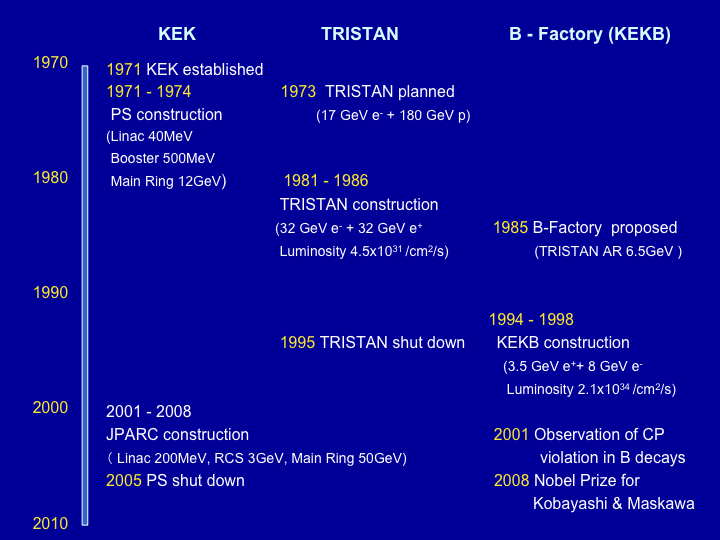
(Click image for larger view)
Almost all of the domestic high energy physicists then were dissatisfied with KEK-PS and thought about higher energy world machines to be built after KEK-PS. In such circumstances Prof. T. Nishikawa, the head of the KEK Accelerator Department, proposed the TRISTAN project in 1973. The TRISTAN machine initially planned was a three-ring beam collider to facilitate various types of beam collisions. e+e-,e-p, and pp.
In the 1970s, the standard theory to describe the elementary particle was steadily established by experiments, and the Kobayashi-Maskawa(K-M) theory published in 1973 was widely noticed as a basis of the standard theory. Hence the Japanese high energy physics community rightfully hoped that the new machine after KEK-PS should be one to investigate the validity of the K-M theory and lead the theory to Nobel Prize.
The K-M theory states in brief that the violation of CP invariance can be explained as state mixing of six types of quarks. Three quarks, (u,d,s), were known in 1973, and forth and fifth quarks, c and b, were discovered in 1974 and 1977, respectively. Then, to verify the K-M theory, experiments to be done were to find sixth quark, t and to show the CP invariance violation emerges in accordance with the K-M theory's prediction. In late 1970s, there were some theoretical predictions that ![]() mass plausibly ranged from 50 to 60GeV/c2. And after thorough discussion it was decided that TRISTAN should be an e+e- collider reaching 30GeV+30GeV and aim at finding t quark, though the KEK site did not seem to be large enough to build a realistic machine of this energy range.
mass plausibly ranged from 50 to 60GeV/c2. And after thorough discussion it was decided that TRISTAN should be an e+e- collider reaching 30GeV+30GeV and aim at finding t quark, though the KEK site did not seem to be large enough to build a realistic machine of this energy range.
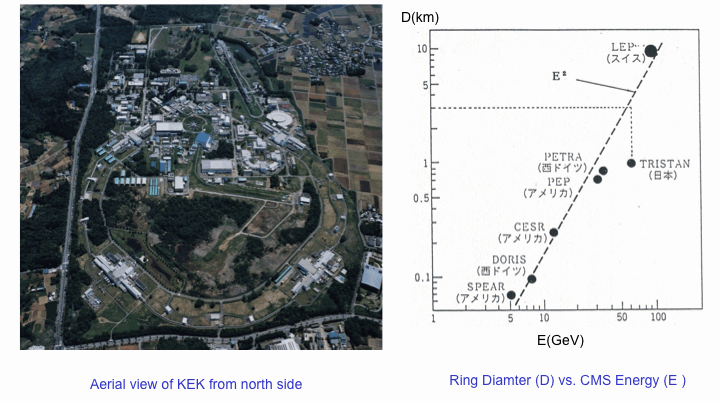
It is well-known that the optimally designed e+e- collider ring follows the rule to enlarge the diameter in proportion to a square of beam energy. And the optimum diameter of a 30GeV ring is given to be about 3km. But the largest ring fit in the KEK site was estimated to be about 1km in diameter. Therefore the TRISTAN ring had to be designed so that a huge radiation loss in the relatively small ring could be compensated with an efficient high power RF accelerating system. To cope with this requirement, the ring was designed to have unusually long straight sections (98m x 8) for RF cavity installation, and a great deal of effort was concentrated in developing new high power UHF accelerating components, which included APS type normal conducting cavity system, world first large-scale superconducting cavity system, klystron tubes with world highest continuous out-put power, liquid He system with domestically highest cooling power, etc.
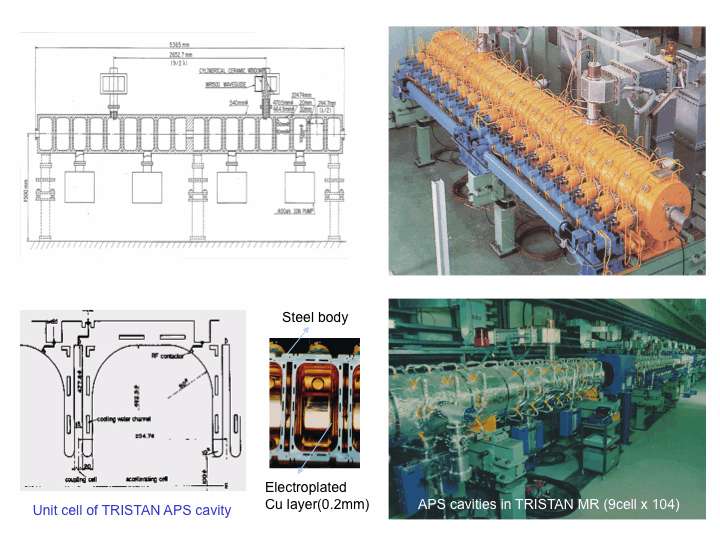
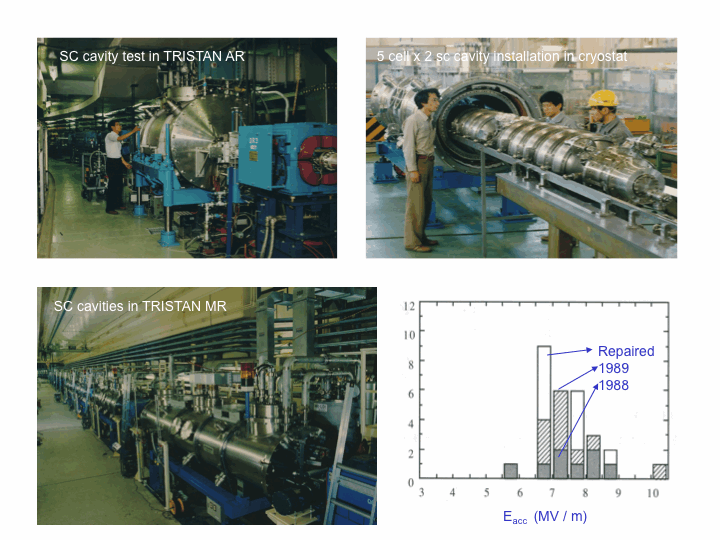
In addition, TRISTAN as the first beam collider in Japan required development of new technologies such as all aluminum alloy vacuum system, superconducting quadrupole magnet for low-beta insertion, wholly centralized computer control system, and versatile computer code for beam orbit analysis.
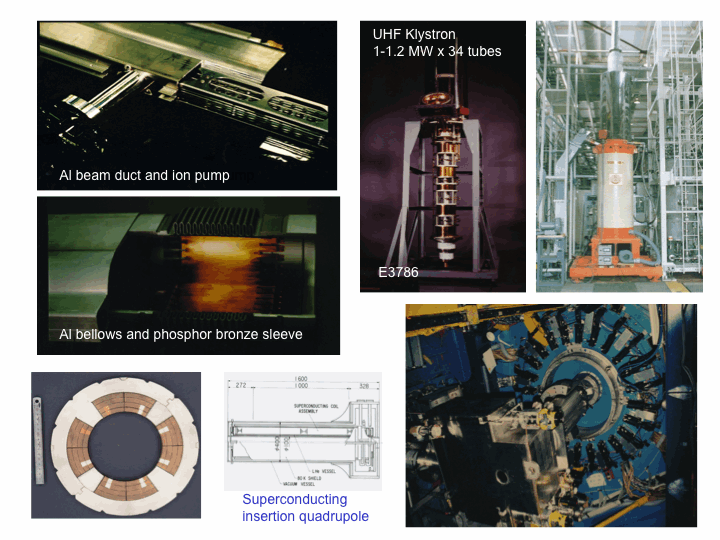
The TRISTAN construction was completed in 1986 as planned, and experiments to look for tt were carried out. But before long it turned out that the ![]() mass was much heavier than expected and in the energy range beyond TRISTAN. Then some study groups were organized and investigated a possible construction of a B-factory for CP violation experiments in parallel with the TRISTAN project. What promoted this B-factory plan to a realistic one was an idea of the asymmetric energy two-ring e+e- collider proposed in late 1980s. In 1993 the government accepted the KEK proposal that KEK began the construction of an asymmetric energy B-factory(e+/e-=3.5GeV/8GeV) in 1994 provided that the TRISTAN facilities could be maximally utilized, and completed the TRISTAN experimental program was completed by 1995.
mass was much heavier than expected and in the energy range beyond TRISTAN. Then some study groups were organized and investigated a possible construction of a B-factory for CP violation experiments in parallel with the TRISTAN project. What promoted this B-factory plan to a realistic one was an idea of the asymmetric energy two-ring e+e- collider proposed in late 1980s. In 1993 the government accepted the KEK proposal that KEK began the construction of an asymmetric energy B-factory(e+/e-=3.5GeV/8GeV) in 1994 provided that the TRISTAN facilities could be maximally utilized, and completed the TRISTAN experimental program was completed by 1995.
In order to investigate the CP violation, the KEK-B collider was required to achieve the luminosity as high as 1034cm-2s-1 , or the stored beam currents exceeding amperes, almost two to three hundreds times of those TRISTAN attained. And to reach this luminosity goal, the KEK-B accelerator team had to overcome a lot of difficulties. But shortly after the machine completion in 1998, they could attain the unprecedentedly high luminosity of 2.1x1034cm-2s-1 and brought the B-factory project to a great success. As a matter of fact, in 2001 the experimental group succeeded in observing the CP violation in B meson decay, and this eventually lead the K-M theory to winning the Nobel Prize in 2008.
〜 Author : Yoshitaka Kimura Senior Advisor, High Energy Accelerator Research Organization 〜


